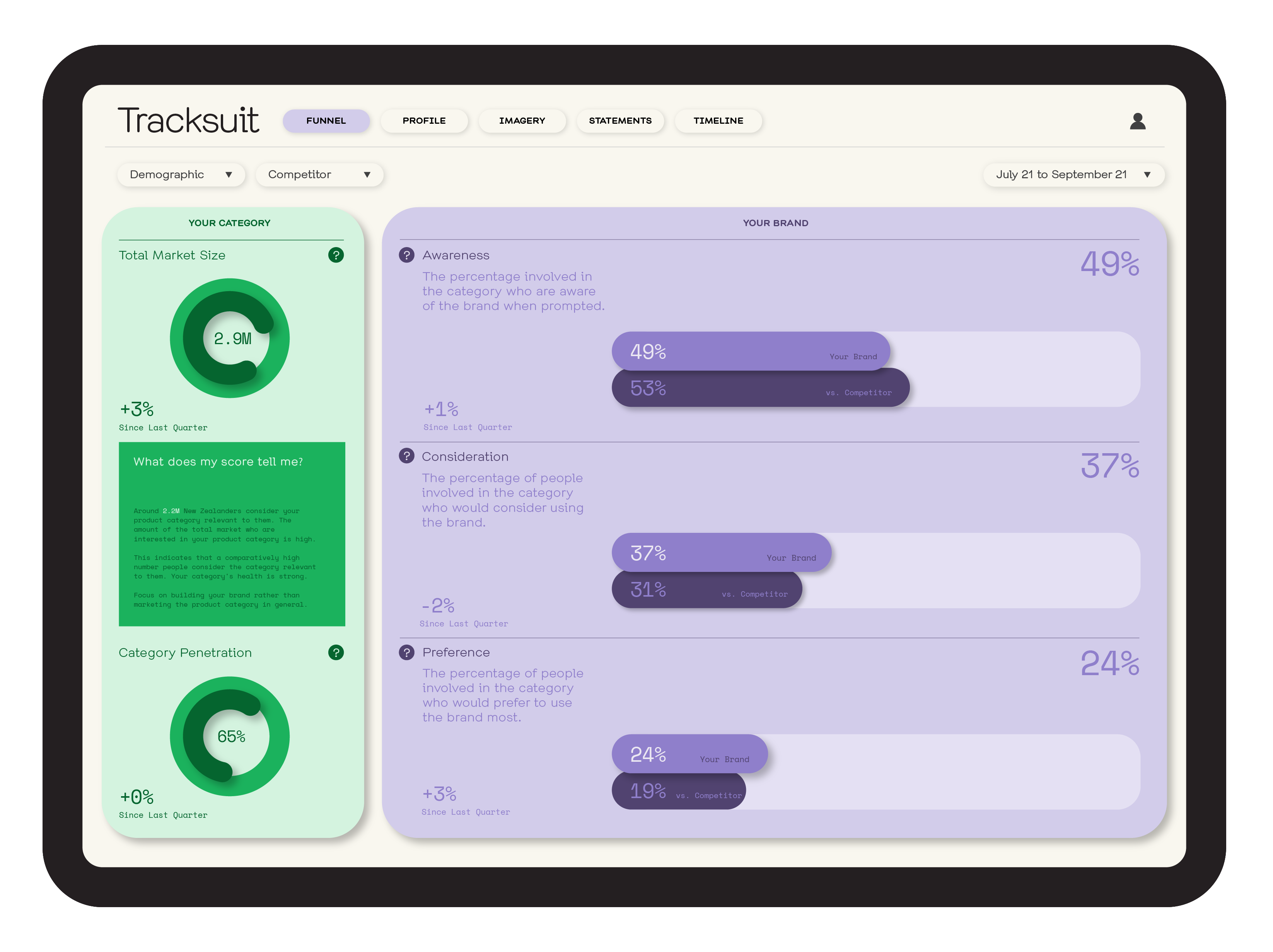Brand Management: Everything You Need to Know

There’s a million guides out there on how to create a brand. Name? Check. Memorable tagline? Check. Awesome logo? Check.
But managing a brand? That’s a whole other story – and one we hear far less about.
Why? Because brand management is a bit like parenting. Your brand may have flown the nest, but there’s no neat end point where you can tick a box and say you’re ‘done’. That constant worry of ‘am I doing this right?’ will remain, no matter whether your baby (ahem, brand) is five years old or fifty.
This is where brand management is a vital function to provide your company with stability and consistency over the long term. Knowing what your brand is out to accomplish, and how this can be maintained and evolved over time, is the secret sauce of any iconic, successful brand.
Want to know how to join the ranks? Read on.
Sign up to Shorts
For fortnightly brand insights, stories and goodness that'll help you win (we promise).
What is brand management?
Once a brand has been created, a business needs to begin establishing positive associations with its target audience. Because if a brand doesn’t have an emotional pull, why should consumers care about it?
Brand management is a collection of strategies designed to grow and enhance consumer perceptions of your brand, all with the aim of achieving higher levels of brand awareness, customer loyalty, and sales.
When properly invested in, brand management strategies give you a powerful edge over competitors. Careful, consistent brand management is what puts your brand first and foremost in your target customer’s mind when they’re ready to purchase (we call this brand salience) – not paid ads or outlandish SEO hacks.
By laying this strong foundation, brands can weather those inevitable peaks and troughs in the economic calendar, setting themselves up for long-term profitability and success.
Why is brand management important?
Choosing all the visual elements of your brand can feel like a headache. But it’s actually the easiest part of creating a brand. As Mark Ritson, global brand management expert, puts it: “The first thing they teach you in brand management infant school is that brands are more than logos.”
After all, a designer can have a logo and typeface whipped up and ready for use in a matter of hours. Building trust and loyalty in your brand? That takes years, if not decades.
To achieve this, you need to ensure that your brand – and the values it represents – stay consistent and relevant as your business evolves. This is where many companies end up falling into obscurity. Why? Because they don’t have a robust brand management strategy in place.
Picture any iconic brand, from the Nike swoosh to Apple’s minimalist silhouette. Chances are it’s not just the logo that’s committed to memory. It’s been ingrained into us that Nike is committed to high performance and excellence, while Apple is a byword for refined design. We don’t need someone to tell us this; we just know
This innate understanding isn’t down to luck. It’s the result of decades of careful brand marketing management that influences how consumers perceive what a brand represents. Nike and Apple don’t need to waste valuable marketing dollars telling consumers why they are good at what they do; these deeply-embedded brand associations do the work for them.
In sum, strategic brand management boasts a greater ROI than any marketing strategy on the planet. Ensuring that your brand stays true to what it stands for fosters familiarity and recognition and is what transforms customers into brand advocates – which is something that cannot be bought with mere advertising dollars.
Brand health is a way to measure how your brand is perceived in your market, and knowing these metrics plays a key part in effective management. Here's why you should be tracking your brand health
Brand Management Strategies
Understand your gap in the market and articulate it
Knowing what makes your business different isn’t just savvy marketing. It’s essential for good brand management and knowing how to position your brand relative to competitors.
For example, the famous ‘Pepsi challenge’ advertising campaign in 1981 found that consumers overwhelmingly preferred Pepsi to Coca-Cola in blind taste tests. Yet Pepsi experienced no attributable increase in sales as a result.
Why? Because while the campaign proved that Pepsi made the better product, it offered no compelling value proposition for why consumers should switch their brand allegiance. After all, being the ‘better Coke’ is hardly a tagline to set the world on fire.
So, rather than capitalizing on the success of the ad by providing a better vision and positioning their soda as a lifestyle not just a drink (something Coke is famous for doing), Pepsi let itself slide out of the conversation.
The lesson here is that it’s not enough to be ‘as good as’ or even ‘better’ than your competitors; if they have stronger brand equity, they’ll beat you almost every time. Being able to articulate the why and the how behind your brand is essential to winning over consumers - and keeping them.
Stay aligned with what your target audience knows and wants
You’re built your brand, and have a decent market share and solid recognition with your intended audience. Now what?
It’s easy to rest on your laurels and leave your brand as is, but the old ‘if it ain’t broke, don’t fix it’ rule doesn’t apply when it comes to branding. Why? Because this can put businesses on a path to making drastic changes all at once, disorienting customers and threatening brand trust.
The infamous Tropicana rebrand of 2009 is a classic example of poor brand management – and the result wasn’t pretty.
Tropicana decided to ditch its classic packaging in favor of a more ‘modern’ and minimalist style. But Tropicana had completely overlooked the appeal of the old-fashioned design, and experienced such an impassioned response from angry customers that they dropped the rebranded packaging within months.
“We underestimated the deep emotional bond [customers] had with the original packaging” […] “What we didn’t get was the passion this very loyal small group of consumers have. That wasn’t something that came out in the research. […] Those consumers are very important to us, so we responded.” Neil Campbell, President of Tropicana North America.
As Mark Ritson says, it’s important to reinforce before you get reflexive, opens in new tab with your branding. Put simply, don’t go changing up your brand until it's extremely well established and recognized, and only then can you get playful with it.
Tropicana offers a cautionary tale of what happens when a business isn’t in touch with what its customer thinks and feels. A brand should never stay static, but any changes to visual elements or brand voice need to be phased in carefully to avoid confusion – and with the full endorsement of your loyal customers. Focus groups and even social media polls are valuable tools to test different concepts and stay aligned with your audience.
Organize your brand assets
When someone mentions brand assets, it’s easy to think about the obvious pieces of collateral such as logos and brand colors. But your brand toolkit (which sits within your responsibilities as a brand manager) are far broader than you might think.
A brand isn’t limited just to what consumers can see; it’s a whole ecosystem that includes anything your audience can read, listen to, or associate with your brand. This means your website, app, social media accounts, brand messaging, tone of voice, and even your employees also count as brand assets - and you need to manage them carefully to maintain brand consistency.
For example, even a logo is a more complex asset than it might appear. Logos are a combination of multiple assets, the logomark (the graphic) and the logotype (the brand name). Brand should have multiple versions of the logo ‘lock up’ (the logomark and the logotype) for use in different formats. All of these assets need their own set of guidelines for when and where it can be used, or this could affect brand recognition.
At Tracksuit, we have a whole lot of fun with merch. You’ve probably seen a picture of a track team member wearing one of these fits (in fact, our co-founder, Connor, wore one at his first big pitch event, a formal evening in front of 800+ investors). These threads aren’t just for comfort, they’re an extension of our brand - a brand asset that reflects our nimble, fast (and ahem, beautiful) approach to brand tracking. We’ve turned traditional brand tracking on its head, including the usual suits that we’ve all been privy to in the past. What’s even cooler, is that all our mates, customers and team members actually want to wear these tracksuits. In fact, we can’t make them fast enough – our waiting list is steadily growing.
By creating comprehensive standard operating procedures (SOPs) for all of your assets, you can make sure that your branding and marketing teams are always following best practice.
Brand Management Courses
Brand management is a specialist area that isn’t always covered in-depth within traditional marketing programs. If you’re planning on adding brand management to your responsibilities, it’s a good idea to dive into some additional learning to make sure you understand best practice.
Here are some of our top picks for brand management courses, which, of course, should be supplemented by getting your company set up with a brand tracking tool – you know who to come to for that (hint: that’s us!)
Mini MBA in Brand Management with Mark Ritson
Mark Ritson is a former adjunct Professor of Marketing at Melbourne Business School, with decades of brand management experience working with major international brands including Subaru, De Beers, Ericsson, and Sephora. This 12-week course is designed both for brand managers and marketers who are keen to enhance their understanding of key branding principles, with the 10 modules covering topics such as brand equity, brand positioning, tactical execution, and brand tracking.
In addition, the course also includes Q&A sessions with Mark Ritson himself on a twice-monthly basis, as well as long-term access to Marketing Week and HBR case studies. With a recommendation rate of over 90% from alumni, it’s a firm favorite within the branding space.
Price: $3,042 NZD / $2,751 AUD + GST
Brand Management: Aligning Business, Brand and Behavior
Offered by the London Business School at the University of London, this course expands the idea of branding from just visual elements and design to branding as an experience that attracts and retains customers – if it’s executed and managed well.
Led by Professor Nader Tavassoli, the course offers 5 modules that cover the key touchpoints with employees, consumers and other key stakeholders that brands should use to capture and deliver value.
Price: Free access to course materials. $78 NZD / $70 AUD for certification
Strategies That Build Winning Brands - Kellogg School of Management
In such a competitive marketplace, it’s becoming increasingly difficult for businesses to compete on the basis of product and price alone. In sum, it’s essential to know how to differentiate your brand on the basis of identity and values.
Against this backdrop, Kellogg’s brand management course focuses on how companies can develop memorable brand positioning and measure their long-term brand health. The 6 interactive modules over a 6-week period are tailored towards any marketing and branding role that drives growth, whether that’s via CX, supply chain, or general management.
Price: $3,544 NZD / $3,201 AUD
Master of Advertising Effectiveness
This brand-new online course is designed and facilitated by James Hurman, a veteran of the advertising industry and founder of Previously Unavailable, a world-class innovation and brand consultancy firm (and investor of Tracksuit!)
Named the world’s #1 strategy planner in 2013, James’s 6-week program is designed to bring together the fundamentals of great advertising with how to effectively manage both short and long-term branding activities.
Price: $2,995 NZD / $2,690 + GST
Brand Management Platforms
No matter whether you’re a rookie or a veteran at brand management, investing in a dedicated brand management platform provides a consistent point of truth for your efforts. Brand management software can help you visualize your brand’s performance and see how consumers are responding to your activities.
Tracksuit was designed with the understanding that standard performance metrics are unable to capture the long-term nature of brand building and brand health. The interactive dashboard sheds light of those tricky insights that were once impossible to access without the aid of costly research firms.
Built to mimic the stages of the customer journey, Tracksuit users can map out the success of their brand management strategy - right from brand awareness and consideration all the way to preference and usage. Granular competitive analysis makes it easy to see where your brand is sitting relative to your competitors, even down to which attributes consumers are associating with your brand.
But robust data insights are only one aspect of effective brand management. Unless businesses can keep their teams aligned on how to execute brand-building activities, it’s easy for consistency to become unstuck. Asset management platforms such as BrandKit and Frontify offer robust solutions for organizing brand assets and building comprehensive brand guidelines, ensuring that your brand campaigns go live with the i’s dotted and the t’s crossed.

The finishing line 🏁
So, what have we learned about brand management?
- The purpose of brand management is to maintain and nurture your brand image to improve brand equity.
- Strategic brand management is essential to connect with your target audience and influence perceptions of your brand.
- Brand management is far more than managing logos and visual assets; it’s about fostering the total sum of what makes your brand distinct from its competitors.
- If you’re planning on taking a leading role in brand management at your company, consider taking a brand management course to get you up to speed on the key principles.
- Investing in a brand management platform will assist your business in keeping track of all your activities and monitoring brand performance.
Managing a brand is no picnic, but it’s a critical responsibility to ensure that your business always knows where it’s heading.
Your brand should always be your company’s North Star, guiding you to the right decisions on messaging, marketing campaigns, new products, and more.
With an effective brand management strategy in place, you can feel confident in your strategic planning and stay aligned with your most important stakeholder – your customer.



